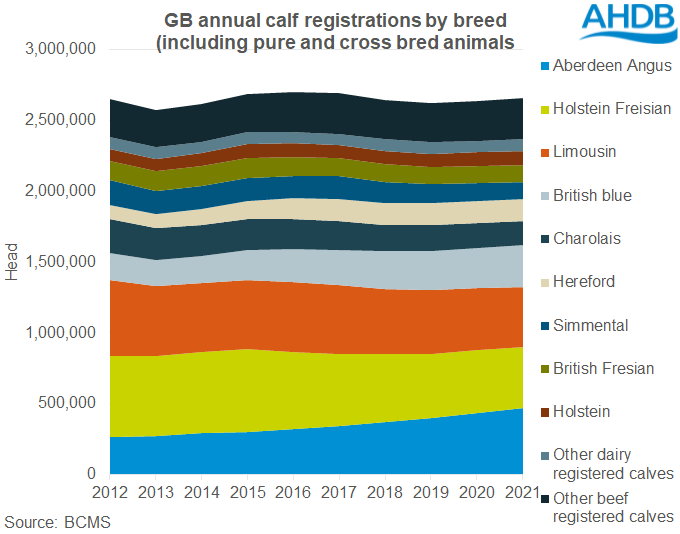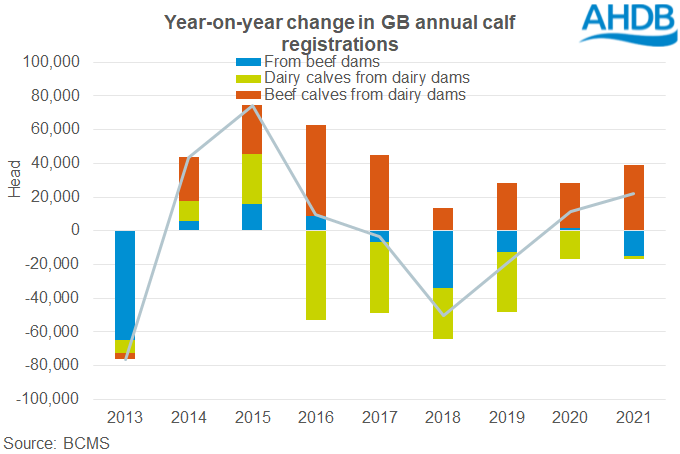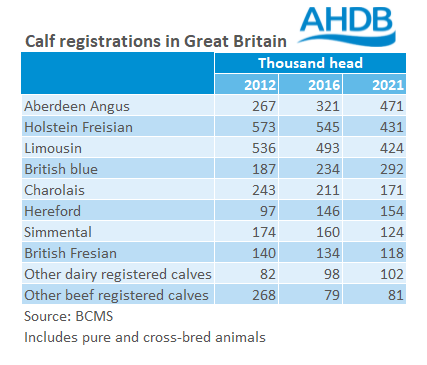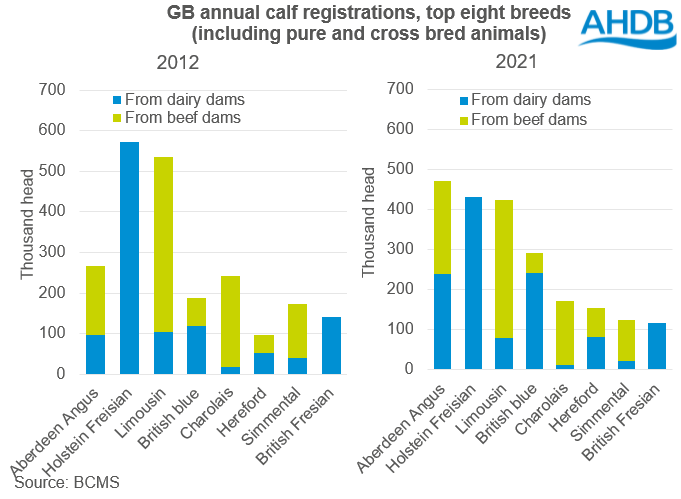Percentage of beef coming from dairy crossed beef calves continues to rise
Monday, 21 February 2022
Births to dairy dams hit a ten year high in 2021, but overall calf registrations were average, according to BCMS data. Although numbers may have been average, the make-up of the national herd has been changing, in part driven by changes in dairy calf management requirements. Ten years ago, just over half of all registrations were for calves born to suckler cows, this has now fallen closer to 45%. There has also been a notable rise in the number of beef registered calves born to dairy dams. In 2012 just over a third of calves born to dairy dams were registered as beef animals; by 2021 the share had risen to a half.

We can see this change within both type of calf, and breed. Among beef calf registrations (from both suckler and dairy dams) there is a clear decline in continental types, and rise in the popularity of native breeds. Some of this change is driven by the usage of beef semen on more and more dairy dams.
Total calf registrations had been falling in the latter part of the last decade, although in 2020 this trend reversed. Over the past five years there has been a mixed picture, with registrations of dairy calves from dairy dams falling while registrations of beef crossed calves from dairy dams rose.

The change in breeding patterns means that the make-up of British beef is changing. As policies surrounding dairy calf rearing change this has a knock-on effect in the type of animals born, increasing use for dairy sexed semen, and increased usage of beef semen. This means more beef produced from the same number of breeding animals.
The combined effects of these changes in farming practices mean that dairy registered animals that once used to make up 13% prime beef* (beef from animals slaughtered before 30 months of age), are now closer to 8%. Equally, around 25% of beef registered calves were to dairy dams 10 years ago, but by 2019 this had reached 33% and in 2021 was 37%. This again demonstrates the rising influence of dairy crossed beef calves on British beef production. Total registrations of beef animals meanwhile have remained relatively flat, as registrations to beef dams have fallen.
With the use of dairy sexed and also beef semen accelerating into 2021, we can expect a continued a shift in the make up of British beef well into the middle of the current decade; a trend reflected in our beef outlook.
*Estimated based upon BCMS data and industry average carcase weights

Sign up for regular updates
You can subscribe to receive Beef and Lamb market news straight to your inbox. Simply fill in your contact details on our online form.
While AHDB seeks to ensure that the information contained on this webpage is accurate at the time of publication, no warranty is given in respect of the information and data provided. You are responsible for how you use the information. To the maximum extent permitted by law, AHDB accepts no liability for loss, damage or injury howsoever caused or suffered (including that caused by negligence) directly or indirectly in relation to the information or data provided in this publication.
All intellectual property rights in the information and data on this webpage belong to or are licensed by AHDB. You are authorised to use such information for your internal business purposes only and you must not provide this information to any other third parties, including further publication of the information, or for commercial gain in any way whatsoever without the prior written permission of AHDB for each third party disclosure, publication or commercial arrangement. For more information, please see our Terms of Use and Privacy Notice or contact the Director of Corporate Affairs at info@ahdb.org.uk © Agriculture and Horticulture Development Board. All rights reserved.


